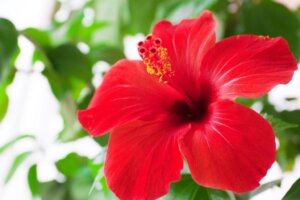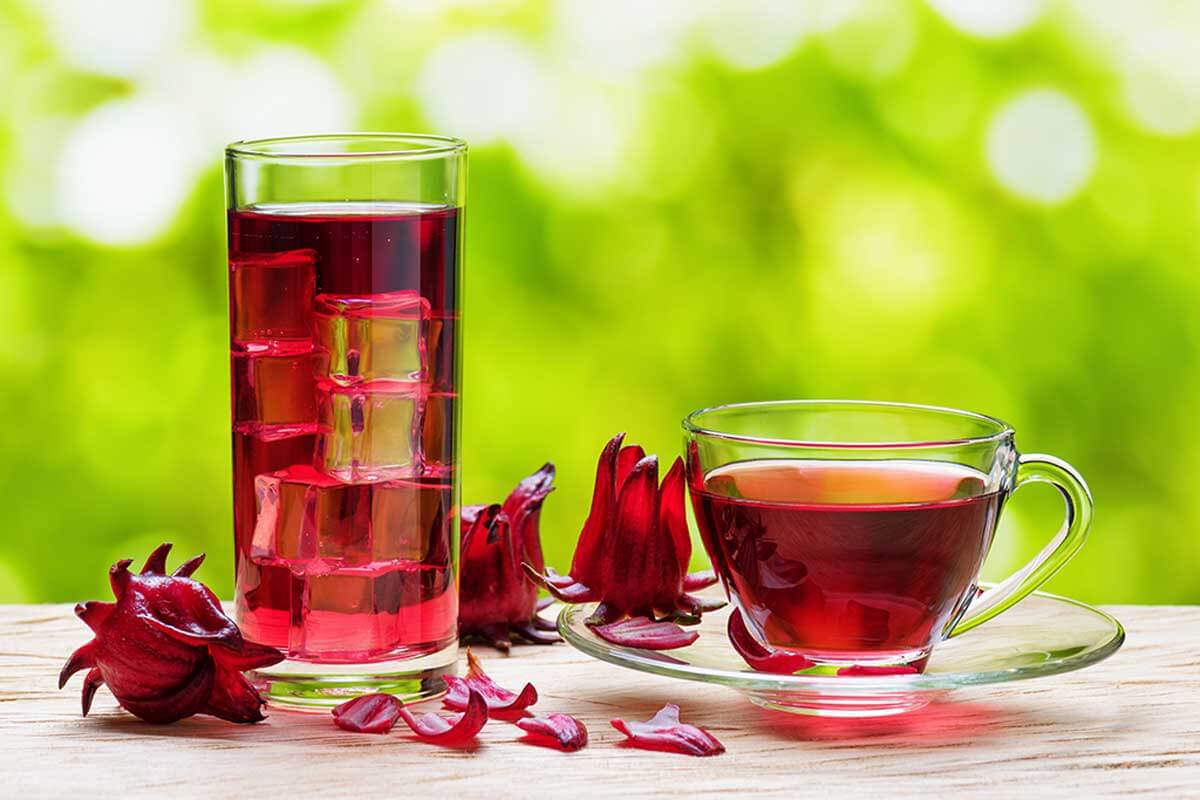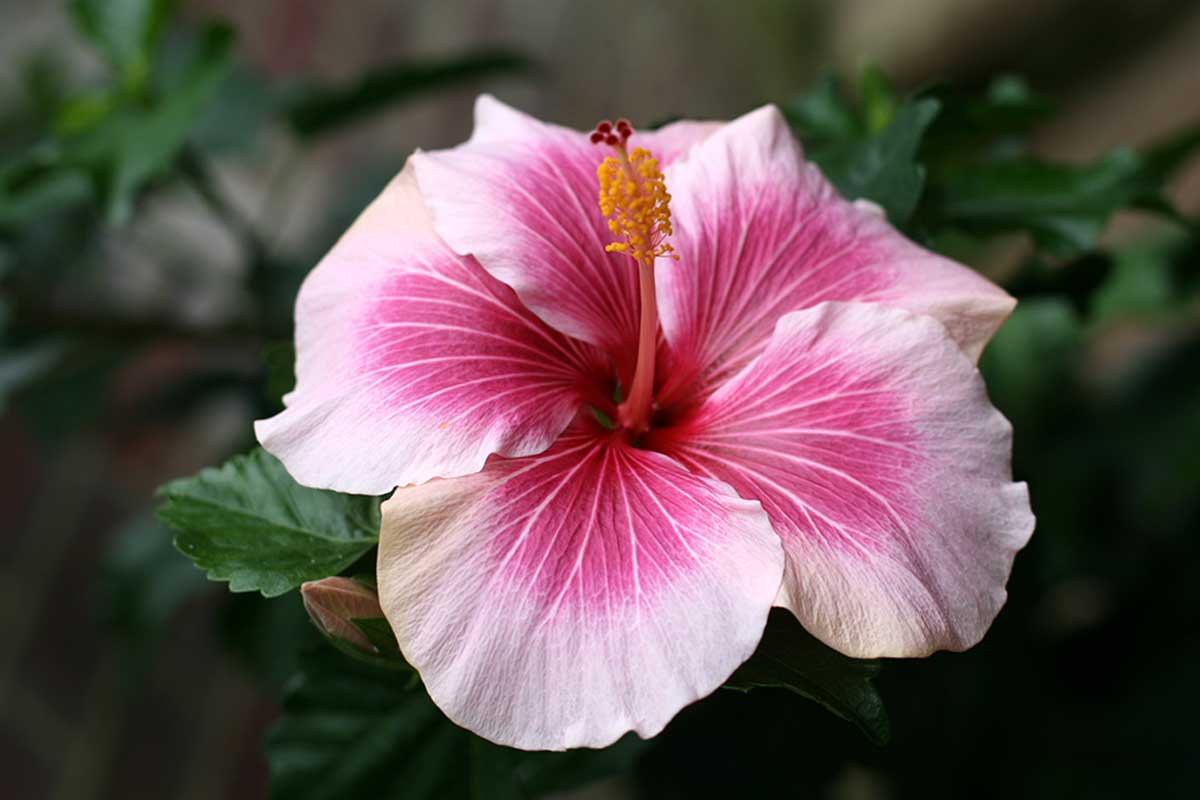Hibiscus: A Beautiful Garden Plant With Beneficial Properties

The hibiscus is from the species of the genus Hibiscus, belonging to the Malvaceae family. Registering over 220 varieties, each one is distinguishable by its beauty. Some have medicinal properties, others are grown for ornamental purposes, and others are used in industry as raw materials for fibers and dyes.
The hibiscus flower is trumpet-shaped, has five petals, and comes in colors such as red, white, pink, purple, and yellow.
Among this wide variety, the common hibiscus or China rose (whose leaves and flowers are edible), and the hibiscus syriacus or Syrian rose stand out. The latter is smaller and cold resistant, but each flowering variety can measure up to 20 centimeters in diameter.
However, if you don’t take the necessary care it can become an invasive plant, dwarfing the other plants in your garden. Keep reading because we’re going to tell you more about hibiscus, its care, and cultivation processes.
The medicinal properties of hibiscus

According to some experts, the hibiscus with the most outstanding medicinal properties is the Hibiscus sabdariffa, commonly known as the Jamaica flower.
Deep red in color, the flowers from this hibiscus are cultivated for medicinal purposes. You can collect the flowers and dry them to make infusions. In fact, you can also use them to make desserts and salads, alongside a variety of other dishes.
They have amino acids, compounds, and phenolic acids that give them their medicinal properties. Among the medicinal benefits, the following stand out:
- Anxiolytics and sedative effects: when used in infusions.
- Activators of circulation: due to the high content of flavonoids.
- Diuretic: helping to clean the kidneys.
- Digestive: provides laxative and intestinal transit activators.
- Antioxidants: contains citric and ascorbic acid.
- Immunological: this is thanks to the vitamin C that these plants contain.
How to grow hibiscus?
The hibiscus needs a moist substrate with good drainage. Ideally, it should be enriched with a little organic matter to make it more fertile which will help the flowering to be more intense.
Most of the species don’t tolerate low temperatures well and instead, they prefer temperate and sunny climates. It’s preferable to grow them in pots so that they can be kept outside in the warmer seasons and brought indoors when the temperature drops.
The ideal time to put the plant in a pot is in spring. In addition to placing it in a good substrate, it’s necessary to use a small pot. This is because when the hibiscus is given a lot of space, it has a tendency to only produce leaves. When the plant has produced flowers it can be transplanted back into a larger pot, especially if the roots begin to protrude from the pot.

Irrigation
Hibiscus watering depends on the season. In summer you should water it every day to keep it moist, but avoid overwatering. Calcareous water isn’t recommended for watering because it can shift the pH of the substrate and make it too acidic. Every now and then it’s a good idea to use a water spray to dampen the leaves directly.
Lighting
For the hibiscus flowers to develop in the best way, it’s necessary to place the plant in a well-lit spot. It can even receive direct sunlight! Although in the summer, ensure that any direct sunlight received is during the morning hours only and not during the hottest part of the day.
The ideal temperature range for this plant to flourish is between 55 and 70 degrees Fahrenheit. You must be aware that this plant doesn’t survive frost.
Feeding
Plant food is very important for hibiscus and you must feed it on a regular basis. Feed it every two weeks from the beginning of summer with a liquid food that’s diluted in water.
Diseases
The hibiscus leaves will reflect the general health of the plant. They warn of the presence of pests and diseases such as:
- Rust: pustules on the leaves can indicate the presence of rust.
- Fungus: if there are white or brown spots there may be fungi.
- Overwatering: for best results, water this plant at the roots. If the roots become sticky or emit a bad smell, you’ll need to try to recover the plant.
- Botrytis: this could be the issue if the leaves show black spots and gray mold.
Enjoy the beauty and properties of hibiscus!
Hibiscus blooms occur in the summer in continental climates and throughout the year in subtropical climates. So, if you have one of these plants at home, follow our advice to enjoy its beauty and beneficial properties for a long time.
The hibiscus is from the species of the genus Hibiscus, belonging to the Malvaceae family. Registering over 220 varieties, each one is distinguishable by its beauty. Some have medicinal properties, others are grown for ornamental purposes, and others are used in industry as raw materials for fibers and dyes.
The hibiscus flower is trumpet-shaped, has five petals, and comes in colors such as red, white, pink, purple, and yellow.
Among this wide variety, the common hibiscus or China rose (whose leaves and flowers are edible), and the hibiscus syriacus or Syrian rose stand out. The latter is smaller and cold resistant, but each flowering variety can measure up to 20 centimeters in diameter.
However, if you don’t take the necessary care it can become an invasive plant, dwarfing the other plants in your garden. Keep reading because we’re going to tell you more about hibiscus, its care, and cultivation processes.
The medicinal properties of hibiscus

According to some experts, the hibiscus with the most outstanding medicinal properties is the Hibiscus sabdariffa, commonly known as the Jamaica flower.
Deep red in color, the flowers from this hibiscus are cultivated for medicinal purposes. You can collect the flowers and dry them to make infusions. In fact, you can also use them to make desserts and salads, alongside a variety of other dishes.
They have amino acids, compounds, and phenolic acids that give them their medicinal properties. Among the medicinal benefits, the following stand out:
- Anxiolytics and sedative effects: when used in infusions.
- Activators of circulation: due to the high content of flavonoids.
- Diuretic: helping to clean the kidneys.
- Digestive: provides laxative and intestinal transit activators.
- Antioxidants: contains citric and ascorbic acid.
- Immunological: this is thanks to the vitamin C that these plants contain.
How to grow hibiscus?
The hibiscus needs a moist substrate with good drainage. Ideally, it should be enriched with a little organic matter to make it more fertile which will help the flowering to be more intense.
Most of the species don’t tolerate low temperatures well and instead, they prefer temperate and sunny climates. It’s preferable to grow them in pots so that they can be kept outside in the warmer seasons and brought indoors when the temperature drops.
The ideal time to put the plant in a pot is in spring. In addition to placing it in a good substrate, it’s necessary to use a small pot. This is because when the hibiscus is given a lot of space, it has a tendency to only produce leaves. When the plant has produced flowers it can be transplanted back into a larger pot, especially if the roots begin to protrude from the pot.

Irrigation
Hibiscus watering depends on the season. In summer you should water it every day to keep it moist, but avoid overwatering. Calcareous water isn’t recommended for watering because it can shift the pH of the substrate and make it too acidic. Every now and then it’s a good idea to use a water spray to dampen the leaves directly.
Lighting
For the hibiscus flowers to develop in the best way, it’s necessary to place the plant in a well-lit spot. It can even receive direct sunlight! Although in the summer, ensure that any direct sunlight received is during the morning hours only and not during the hottest part of the day.
The ideal temperature range for this plant to flourish is between 55 and 70 degrees Fahrenheit. You must be aware that this plant doesn’t survive frost.
Feeding
Plant food is very important for hibiscus and you must feed it on a regular basis. Feed it every two weeks from the beginning of summer with a liquid food that’s diluted in water.
Diseases
The hibiscus leaves will reflect the general health of the plant. They warn of the presence of pests and diseases such as:
- Rust: pustules on the leaves can indicate the presence of rust.
- Fungus: if there are white or brown spots there may be fungi.
- Overwatering: for best results, water this plant at the roots. If the roots become sticky or emit a bad smell, you’ll need to try to recover the plant.
- Botrytis: this could be the issue if the leaves show black spots and gray mold.
Enjoy the beauty and properties of hibiscus!
Hibiscus blooms occur in the summer in continental climates and throughout the year in subtropical climates. So, if you have one of these plants at home, follow our advice to enjoy its beauty and beneficial properties for a long time.
All cited sources were thoroughly reviewed by our team to ensure their quality, reliability, currency, and validity. The bibliography of this article was considered reliable and of academic or scientific accuracy.
- Carretero, M., Ortega, T. Propiedades terapéuticas del Hibisco. Universidad Complutense de Madrid.







